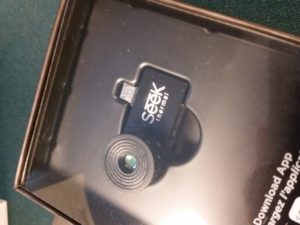Thermal imaging has many uses to hunters and the small devices may change rifle and bow hunting in ways similar to digital rangefinders. Whereas once we guessed distance, now we use an electronic device to precisely measure it. Thermal imaging devices help provide “night vision” in rifle scopes and allow hunters to trail game animals at night, using the heat signature of a blood trail or the carcass of a downed animal.
Bass Pro Demonstration
Last week, I attended a gear presentation by David Fenno, Hunting Lead at the Arundel Mills Bass Pro Shop in which he demonstrated the thermal imaging of two Seek devices, the RevealXR which is the size of a cell phone and a second Seek product that actually attaches to a cell phone. To demonstrate the effectiveness of these devices, Fenno placed his hand on the wall of the room for a few seconds and then walked to the far end of the room. The heat signature of his hand was clearly visible from across the room with the Seek device.
Given this technology, imagine how hunters can better follow blood trails at the end of the day and locate a downed deer or elk after sunset. This technology ranges in cost from $300-500, about the cost of the original laser rangefinders when they were first introduced.
Other Uses

Aside from trailing and locating game, thermal imaging can be used for spotting game out to 300 yards so that you can determine if deer are feeding in a field before you enter or if hogs, coyotes, and other predators are present. Bird hunters will welcome a heat signature when searching for downed pheasants, grouse or quail. Public land hunters can determine if other hunters are in their path as they enter in darkness. John Snow covers other thermal issues in this post from the Outdoor Life website, explaining how the devices work and possible legal complications.
The human eye is a wondrous instrument, but its observational powers are limited to the narrow band of radiation that, not surprisingly, we call visible light. This represents just a fraction of the bandwidth of electromagnetic energy that exists in our universe. And our inability to peer into this vast space with the unaided eye leaves us, both literally and metaphorically, in the dark.
At one end of the visible spectrum is blue and violet. At the other end is orange and red. Once we move beyond red light, we’re in the realm of infrared radiation, which is invisible to our eyes but which we still can detect through the sensation of heat on our skin.



















![The Best Deer Camp Chili [VIDEO] Deer Chili Ingredients, Tomatoes, Chili Spices](/wp-content/uploads/2015/10/Deer-Chili-Deer-Camp-Recipe-218x150.jpg)
![How to Call Elk Early in the Season [VIDEO]](/wp-content/uploads/2016/08/byers003-218x150.jpg)




![Idiots Disturb Hunter: How Would You Have Handled It? [VIDEO]](/wp-content/uploads/2015/10/DSC00110-e1474487693878-100x70.jpg)
![Albino Buck Shocked to Shed His Antlers [VIDEO]](/wp-content/uploads/2015/10/AlbinoDeer-100x70.jpg)